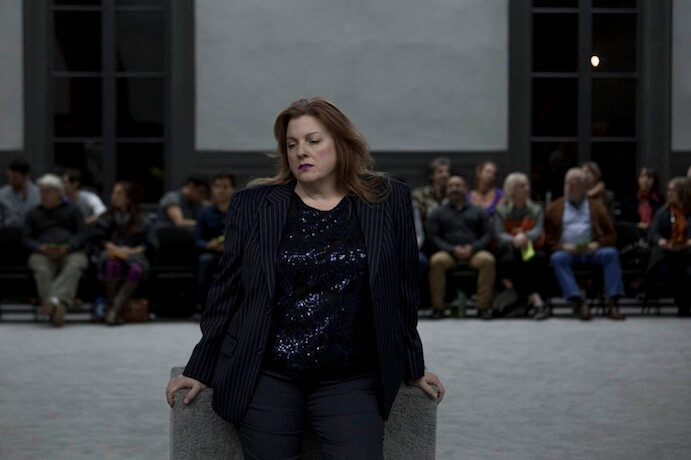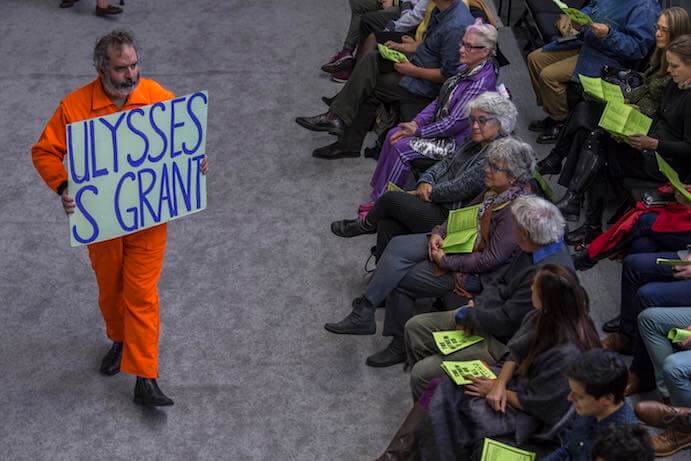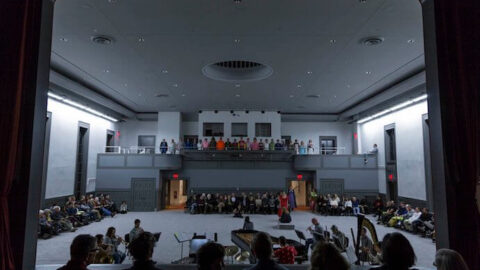Hudson Hall in Hudson, N.Y. hosted a two-week community exhibition directed by R.B. Schlather in November 2017. The event included free thematic programming, educational outreach, and five ticketed performances of Gertrude Stein and Virgil Thomson’s opera The Mother of Us All. Schlather’s operatic exhibition experimented with form to utilize local resources and decrease exclusivity while remaining cohesive through Gertrude Stein’s voice and vision. Lana Norris interviewed participants throughout the process and experienced the opera and additional programming for an extended I CARE IF YOU LISTEN review.
“Brunch chef, stargazer, minister, cybersecurity, music professor. It was heaven, with mice. I lived in Manhattan for 20 years. I immediately became pregnant. Aleba and I rented a ramshackle farm cottage next to a swamp in Copake.” They could almost be lines from Gertrude Stein’s oddly entrancing opera The Mother of Us All, but they’re cast bios, and short love letters to the Hudson Valley. Director R. B. Schlather and set designer Martha Ginsberg were looking for an opportunity to collaborate in their hometown and watched as Hudson Hall, the oldest theater in New York State, was renovated. It has a history of dramatic and civic presentations including two appearances by Susan B. Anthony when she campaigned for women’s suffrage, so The Mother of Us All featuring Susan B. was an obvious fit.
They imagined activating the entire Hall with thematically related material and multiple access points for the community. “We were starting from nothing, absorbing the aura of the room,” said Ginsberg, “thinking how we might create a more interactive experience in the room for the audience.” They spent four days watching how natural light filtered through the space. The Hall’s refurbished wood floors were too prim for their taste, so they installed plush grey carpet. This lone gesture gave the opera its non-set. Schlather and Ginsberg presented the Hall as the set by staging scenes in every space including back of house and balcony. The audience was eventually seated onstage, around the perimeter, and in the center of the Hall on the carpet. Ginsberg noted that this felt connected to Stein’s work, which takes something familiar and looks at it from different angles. Most of the audience stayed in their assigned seats, but the use of the Hall and staging actors in the center of the audience moved viewers toward more visceral participation.

The Hall also brought Joan Retallack, Professor Emerita of Bard College’s Institute for Writing & Thinking and Stein scholar, who along with Schlather made the connection between The Mother of Us All and the real Susan B. Anthony’s history at the Hall. Retallack knew the inherent musicality of Stein’s libretto but was eager to explore her words combined with Virgil Thomson’s score. Retallack suggested this production can be seen as conversation, not just because of Stein’s discursive libretto, but because of the unusual ways the production extended into the community. It partnered with the Hudson library and Perfect Ten, a local non profit empowering young women through community and cultural engagement, to hold a workshop on Stein’s writings and feminism.
Extended programming included a reading room with low lounge chairs and artists reading work aloud, and “Not-Talk-Back” lectures from local historians and contemporary artists on their work and Stein’s preoccupations. Lil Deb’s Oasis, a local restaurant with performative flair, set up shop in the Hall and was open to the public outside of performances. Its owners Hannah Black and Carla Perez-Gallardo got to know the opera well: their line cook was in the cast and listened to the recording during daily prep.
Stein’s constant dynamic of gravitas and humor anchored the sprawling event, and Michaela Martens anchored the opera. Her Susan B. brought sanity, nuance, and focus to the libretto’s distracted community. Her exhaustion poignantly reflected the challenge of political organizing in today’s fragmented world and the additional opposition women face. Martens’ Susan B. was no caricature of principle, but a clear-sighted woman who sometimes succumbed to cynicism. Susan B.’s close support, Anne, was cast as her romantic partner, and exhaustion took its toll on their relationship. Schlather offset the topics of misogyny, voter suppression, and political engagement by highlighting the inherent humor of local personalities. Two characters danced while Susan B. spoke seriously. One character made absurd use of a prop stool, and briefly sat in the orchestra pretending to conduct. The Mother of Us All was seriously funny.

People who would normally be excluded from the production by profession, genre, or taste were welcomed into unusual opportunities. Schlather held open auditions in the Hudson Valley and hired not only a cast of professional and non-professionals but musicians of different genres. Stuart Quimby, who can reel off hundreds of jazz tunes on flute, joined an opera pit for the first time in the production. His learning curve was steep, but he found it satisfying not only to play the flute’s intimate connection to Susan B. with Michaela Martens’ meticulously phrased singing but also see audience reactions. “There are certain parts I scan the audience,” he said, “and I see all the women are like, ‘We’ve been there, the men are great until we’re not in line.’ It’s interesting to look at the faces.”
“Opera people get irritated when I bring this up,” he continued. “[There’s often] gorgeous music, amazing singers, beautiful sets, and weak storyline. But this has narrative: even though it’s fragmented, you’re following the progression of Susan B.” Ginsberg had a similar experience being absorbed by the opera despite herself, and Joan Retallack agreed. “I’m in love with it and not entirely sure why,” she said. “The small permutations of [Stein’s] books are like looking at Philip Glass notation. I finally came to love it in what I think is a funny dialogue with Stein’s notational rhythms that she makes with words and [Thomson’s] sweeping melodies and marches.”
The libretto is not an easy one for audience or musicians: full of things to sing or hear that are in odd rhythms and incomplete understanding. But the extended programming contextualized Stein’s ideas to modern day and increased access for opera no-goers. Schlather’s staging, with 360-degree action, shifting acoustics, and audience mobility made it impossible to take it all in, so Stein’s style of images floating in and out was transformed from barrier to accurate depiction. Like community life, things changed depending on point of view. The audience in the center of the action, like Susan B. and Anne, struggled to see the production as a whole, while those on the periphery missed some interactions. Setting aside the expectation for total comprehension created freedom for authentic engagement with immediate performance.
Despite its efforts to address socio-economic barriers to opera, the production attracted a mostly white, middle-aged crowd. The opera itself would not have offered obvious racial commentary without transparent communication from the creative team. Aside from credits and unusually interesting bios, the opera’s printed program existed primarily for this purpose. Dramaturg Joan Retallack noted the opera’s intricate community dynamics and highlighted two unnamed African-American characters in the libretto. “The ethical issue their anonymity foregrounds (recalling slaves’ stolen personhood) is urgent as we stage this opera in the current atmosphere of white supremacist rhetoric, as we perform it in Hudson, whose population is 40% citizens of color, 25% of that African-American.” Proposed changes to the libretto were denied permission, so the discourse was incorporated in extended programming.

At the end of the opera, women can vote, but the community is still conflicted. Men still resist Susan B.’s efforts: Ulysses S. Grant says “bah the vote” entirely, Daniel Webster has not moved, and Jo the Loiterer is ambivalent toward his progressive wife. But there is evolution: Indiana Elliot defines marriage on her terms and votes. Susan B.’s finale charges the next generation and bleeds into present day. Reflecting on the production, Ginsberg was also moved by the opportunity to engage timely issues and forge special communal bonds in the process.
The human and highly site-specific nature of The Mother of Us All complicate future presentations; production coherence would be retained by process and principle. “Stein is a kind of constant living, shifting lesson in poetics that are composed as part of the context of the contemporary moment,” Retallack said. “She basically said that we are all composing our contemporary moment in what we are doing in that moment, and it’s the doing of these things that make the moment as something that’s moving away from the past. I have no doubt that she would be absolutely delighted that this work is being performed in a community that is becoming activated.”
























